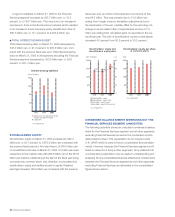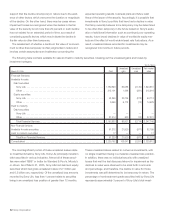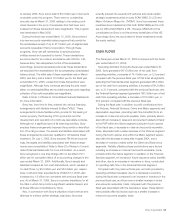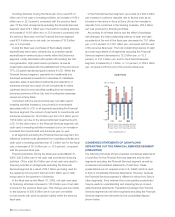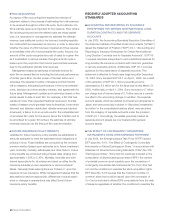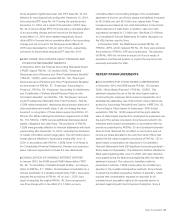Sony 2005 Annual Report Download - page 63
Download and view the complete annual report
Please find page 63 of the 2005 Sony annual report below. You can navigate through the pages in the report by either clicking on the pages listed below, or by using the keyword search tool below to find specific information within the annual report.60 Sony Corporation
TREND INFORMATION
This section, including the Forecast of Consolidated Results,
contains forward-looking statements about the possible future
performance of Sony and should be read in light of the caution-
ary statement on that subject, which appears on the inside front
cover page and which applies to this entire document.
ISSUES FACING SONY AND MANAGEMENT’S RESPONSE
TO THOSE ISSUES
Competition in many of Sony’s business segments continues to
intensify and price erosion, especially in the Electronics seg-
ment, remains persistent. Competition has intensified due to the
penetration of broadband, which has led to an augmentation of
network infrastructure, making it easier for companies in other
sectors to enter the markets in which Sony competes.
In response to these challenges, over the three fiscal years
ending March 31, 2006, Sony is implementing Transformation
60, a series of fundamental reforms aimed at improving opera-
tional profitability and competitiveness in anticipation of future
growth. Through greater focus of management resources on
strategic businesses, accelerated reform of its manufacturing
platform, headcount reductions in administrative (including
corporate) and sales functions and reductions in the cost of
non-production materials, Sony intends to reduce fixed costs.
Sony also aims to lay the seeds for future growth through
strategic investments in research and development, as well as
aggressive capital expenditures in the area of semiconductors.
In addition to this cost-cutting and investment for growth,
each of Sony’s business segments grappled with issues specific
to that segment. Below is a description of the issues manage-
ment believes each segment continues to face and an explana-
tion as to how each segment is approaching those issues.
■ELECTRONICS
Although the Electronics segment continues to hold a very
strong position in the worldwide consumer audio visual products
market, that position has become increasingly threatened as a
result of the entrance of new manufacturers and distributors.
These new entrants are threatening Sony’s position due to the
industry shift from analog to digital technology. In the analog era,
complicated functionality of electronics products was made
possible through the combination of several complex parts, and
Sony held a competitive advantage in the design and manufac-
ture of those parts as a result of its accumulated expertise. In
the digital era, however, complicated functionality has become
concentrated on semiconductors and other key digital devices.
Since these semiconductors and key devices are able to be
mass produced, they have become readily available to new
market entrants, and the functionality that once commanded a
high premium has become more affordable. This has led to
intense price erosion in the end-user consumer audio visual
products market. To respond to these challenges, Sony is
striving to keep pace with price erosion by reducing its manufac-
turing and other costs. It is seeking to maintain the premium
pricing it enjoys on many of its end-user products by adding
functionality to those products and developing new applications
and ways of use that are then communicated to the consumer.
In addition, it is taking steps to increase its competitive edge by
developing high value-added semiconductors and other digital
key devices in-house. By increasing the ratio of key devices
produced in-house, Sony aims to capture the value that has
become increasingly concentrated in those devices.
In the area of semiconductors, in the fiscal years ended March
31, 2004 and 2005, Sony carried out 175 billion yen and 150
billion yen, respectively, of capital expenditure mainly on system
LSIs and CCDs. Of this, Sony invested 69 billion yen in the fiscal
year ended March 31, 2004 and invested 90 billion yen in the
fiscal year ended March 31, 2005 on semiconductor fabrication
equipment built at the 65 nanometer level of process technol-
ogy. Chips that will be manufactured using this equipment will
be some of the most highly advanced on the market, and will
include the Cell next-generation, high-performance processor,
as well as other system LSI for use in the next generation
computer entertainment system PS3 and a variety of future
consumer electronics products. Sony began developing Cell
together with IBM Corporation and Toshiba Corporation in the
spring of 2001. In July 2004, in order to establish a more efficient
and coordinated semiconductor supply structure, Sony has
integrated its semiconductor manufacturing business by transfer-
ring Sony Computer Entertainment’s semiconductor manufac-
turing operation from the Game segment to the semiconductor
category within the Electronics segment.
In the area of other key devices, Sony invested in 7th genera-
tion amorphous TFT LCD panel production equipment, through
a one billion U.S. dollar investment in S-LCD, a joint venture with
Samsung, based in South Korea. This investment reflects Sony’s
belief that demand for LCD televisions will continue to increase
rapidly. Samsung holds 50 percent plus one share of the equity
of the joint venture while Sony holds 50 percent minus one
share of the equity of the joint venture. The President and CEO
comes from Samsung while the CFO comes from Sony. Produc-
tion of LCD panels began in April 2005. Expected production
capacity is 60,000 sheets per month at the 7th generation
(1,870 mm x 2,200 mm) level of technology.
■GAME
In the Game segment, PS2 has a high share of the global game
console market, and the PS2 business, particularly the PS2
software business, remains in its harvest stage. However,
production shipment units of PS2 hardware are expected to
decrease in the fiscal year ending March 31, 2006. In order to
BH6/30 Adobe PageMaker 6.0J /PPC


